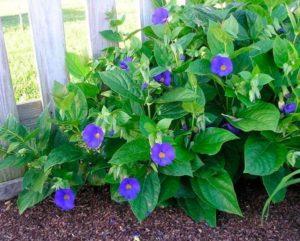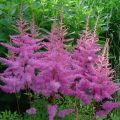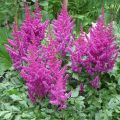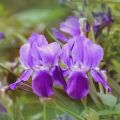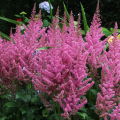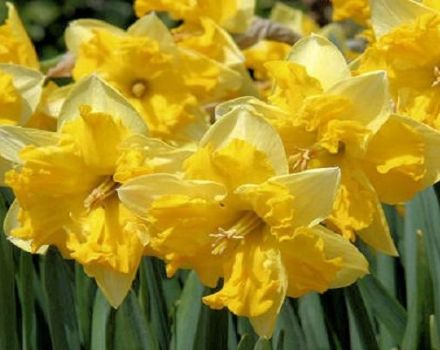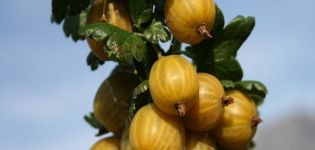Description and characteristics of the Delft Lace variety astilbe, planting and care
The origins of the history of astilba, called Delft Lace, go back to a relatively ordinary-looking plant that grows in the South-East of our continent and the territory of Japan. It became famous among botanists in 1825. Not impressive in appearance. Presumably "astilba" and then meant "without shine."
The history of selection of the Delft Lace hybrid
She acquired a real brilliance thanks to the talent of the German breeder Georg Arends (1862-1952). Its hybrids are the cultivated descendants of Japanese, Chinese riverside, David and Thunberg astilbe. Among them is the extraordinary astilbe Delft Lace (Delft Lace). Among other hybrids, it is unusual for its large openwork inflorescences and a lace rosette of carved leaves that change color during the season. Therefore, it is named Delft lace. Delft is the first de facto capital of the Netherlands.
Description and characteristics of the plant
Astilba is generally one of those plants that now occupy an increasing place in our gardens. In addition to its spectacular appearance, it attracts with its unpretentiousness. And responsive to the basic care available to any beginner. And Delft Lace is one of the best.
The appearance of the bush and the branching of the root system
The Delft Lace astilba bush is stocky and strong, with foliage up to 30 cm in height and up to half a meter in width. Height with panicles - 60-80 cm. At the time of flowering and under favorable conditions, it enchants with graceful forms, rich colors and delicate aroma.
Lacy dark leaves with a waxy bloom surprise with the transition of colors from burgundy, in spring and bright green in summer, to green-blue by autumn. The red-brown stems raise a fluffy openwork inflorescence above the dense foliage. The shape of the inflorescence is conical. Spring buds are salmon-colored with a pink tint. The flowers are deep pink.

Delft Lace rhizome, more and more powerful with age, diverges into many strong branches extending into the depths of the soil. The peculiarity of the astilba root system is that it grows from above. Buds are tied, giving rise to more and more new roots, the lower part of which gradually dies off. Therefore, it is necessary to fill up the soil from time to time at the base of the bush.
All about blooming
Astilbe Delft Lace blooms profusely and continuously in July-August.The air cloud of paniculate inflorescence for more than a month pleases with tints of pink shades. At first, whiskers draw attention from afar. Then you notice their dazzling contrast with the greenery of the bush.
The thickets of flowering astilba make a strong impression when several bushes are planted nearby. Delft Leis is a wonderful honey plant and attracts a huge number of bees and butterflies.
A young plant, planted in spring by dividing the root, blooms in the year of planting. Grown from seed - in the third year.

Frost and drought resistant
Astilba is grown without problems in most of Russia. Delft Lace is frost resistant down to -35˚C. But according to gardeners, it can withstand -38 –C.
Tall astilbe is more resilient, climatic changes and temperature changes are not afraid of them. And in rainy seasons, when other plants rot and are affected by fungal diseases, Astilba feels very confident.
Extremes are contraindicated for her: stagnation of moisture and lack. That is, Delft Leis will not endure a multi-day drought. Sometimes even a plant revived by watering will no longer be able to please with abundant flowering. And the long flowering of astilba is possible with constant soil moisture.
What diseases and parasites are dangerous for a flower
It is about Delft Lace astilbe that gardeners speak of as resistant to diseases and pests. However, she is sometimes affected by the slobbery penny and nematodes (strawberry and gallic).
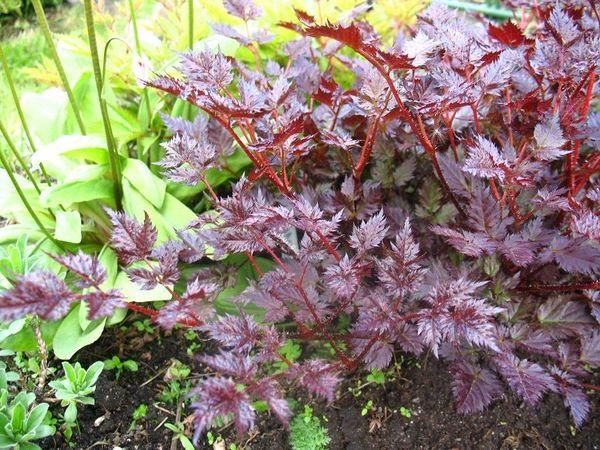
The stump hits the leaves. They curl, become stained. The bush fades partially or completely. At the first sign, it is necessary to treat the plant with insecticides.
The strawberry nematode also damages leaves, flowers and buds. Especially possible during periods of high humidity. Gallic plant settles on the roots of astilbe, forming growths in which larvae develop. It is impossible to cure a plant that has been attacked by nematodes. If they appear, the following measures are required:
- remove and destroy affected plants;
- astilba and other crops from the risk group should not be grown on this site until 4-5 years.
For prophylaxis, the acquired planting material is recommended to be etched with growth stimulants ("Gumi", "Epin") before planting.
As for slugs and snails, according to the observations of gardeners, they are indifferent to astilbes.
Application in landscape design
The use of astilbe in the landscape creates unlimited possibilities for the designer's imagination. Especially when it comes to Delft Lace. General advantages of astilbe:
- perennials;
- moisture-loving;
- easy to care for;
- decorative.
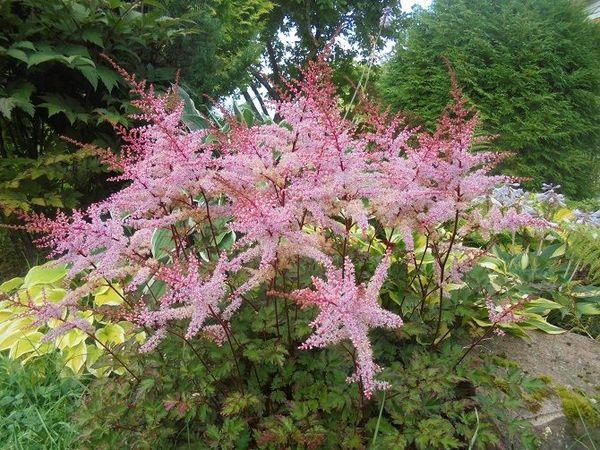
And Delft Lace still prefers light shading. And its foliage fancifully changes color during the season. Therefore, it is good everywhere:
- solo;
- in groups;
- in flower beds;
- near water bodies;
- in semi-shaded compositions;
- with bulbous;
- conifers;
- decorating unsightly elements of the landscape.
And also: very good at cutting.
Landing astilba
Timing
Astilba Delft Lace is usually planted in the spring. Although, with the democratic nature of astilba, this can be done in the fall a month before the onset of cold weather (at least + 5˚C). In central Russia, it is about September. It is possible in summer, only better in cloudy weather.
Planting material
The roots should not be:
- rotten;
- too wet;
- overdried.

And the sprouts:
- elongated;
- thin;
- pale;
- curved.
Such seedlings will not take root well and will hurt for a long time.
Store the selected Astilbe roots in the refrigerator before planting, checking from time to time their condition.
Optimal location
The site for planting astilba should be at least shaded during the hottest part of the day. Delft Lace prefers diffused shadow, although it will endure any illumination. But in partial shade it blooms for 1-2 weeks longer.
Wet soil is the main condition. Nearby groundwater would be suitable. No waterlogging.The increased air humidity near water bodies or fountains will be an additional plus.
Required soil composition
Astilba Delft Lace is absolutely unpretentious to soil conditions, but if there is a choice, it would prefer loam. On too fertile soil, astilbe begins to fatten. And clay is not allowed: soils should be light. With increased acidity, wood ash or dolomite flour is added.
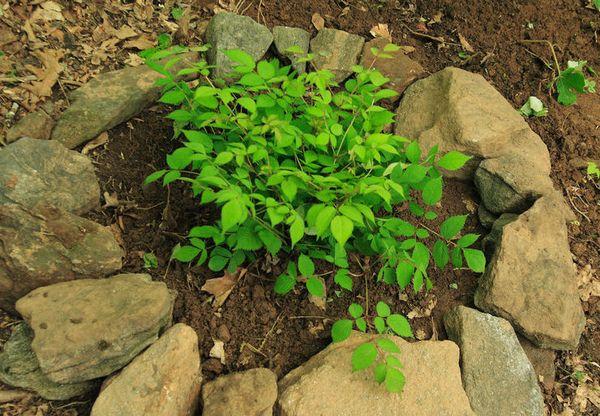
Landing technology and scheme
When planting Delft Lace in the soil, follow the general recommendations for astilbe:
- Fertile soil, ash, humus are poured into a hole larger than the radius of the root growth. By a little.
- Before planting, for disinfection, the little pieces are soaked in phytosporin.
- With a solution of phytosporin, gumi, epin and growth stimulants, a planted bush can be shed to support immunity and relieve planting stress.
- Sprinkle the root collar of the plant about one and a half cm. Not more.
- If planted at a distance of 30 cm, the result is a flowering carpet over time.
- When disembarking in sunny weather, the bushes are covered for 2-3 days with some kind of shelter, such as, for example, a large flowerpot or basin. Shoot in cloudy weather or in the evening. Better in the rain.
- Feed with herbal infusion or well-rotted manure.
- Mulch so that the soil does not dry out.
We organize competent care for Astilba Delft Lace
Irrigation and feeding
Most of all, Delft Leis is afraid of drought and noticeable interruptions in irrigation. After rooting, the main thing is good watering. When the soil dries out, if the process of leaf drying has begun, it cannot be stopped. Therefore, it is necessary to water the bushes constantly. Especially in dry weather.
In the spring and in the first half of summer, it is recommended to feed the astilba twice with mullein infusion or mineral nitrogen-containing fertilizers. Phosphorus-potassium fertilizers support it after trimming faded panicles. Such feeding will increase the winter hardiness of plants.
Delft Lace does not like soil rich in organic matter and microelements. With an excessively fertile soil, the panicles of the inflorescences become smaller and the plant as a whole becomes smaller.
Formative pruning
After flowering, the peduncles are cut off so that the plant does not waste energy on ripening the seeds.
In addition, periodic pruning is important to maintain the decorative effect of the bush in landscaping.
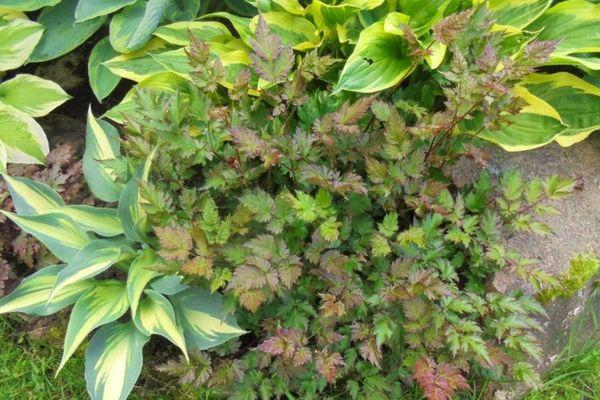
Loosening and mulching the soil
Astilba Delft Lace will gratefully respond to loosening the soil, enriching it with oxygen, simultaneously removing weeds and hilling the upper part of the roots.
The role of mulching in caring for astilbe cannot be overemphasized:
- Prevents weeds from germinating.
- Retains invaluable moisture during hot periods.
- Attracts worms that loosen the soil.
- When decomposed, it turns into a wonderful fertilizer.
Types of mulch:
- dried cut grass without seeds;
- straw;
- well rotted compost;
- chips or bark of coniferous trees;
- pieces of cardboard, decorated with chips;
- coconut circles, not cheap in stores, but very convenient;
- planting siderates (for example, mustard).
Siderata sprout quickly. Pruned with a hoe, they retain moisture, overcooking, become an excellent feeding, and protect against diseases with phytoncides.
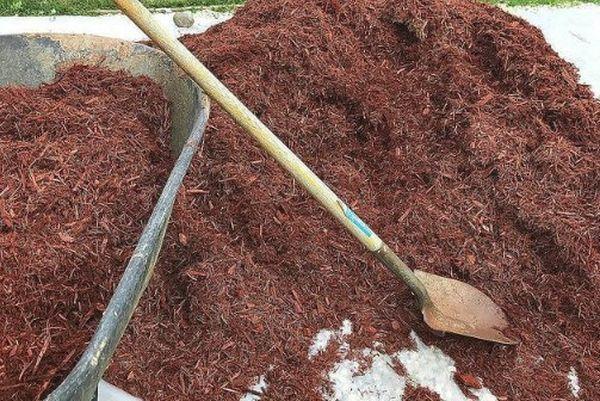
Preparing the plant for winter
We cut off all the tops and cover the astilba root with it. Sprinkle with earth by 4 cm, and then with leaves, peat or chopped bark. Astilba Delft Lace is frost-resistant. But due to possible temperature fluctuations, it is still worth taking care of the upper layer of the roots. Therefore, under each bush you can put rotted compost.
Transfer
Astilbe is seated at least 5 years later. The kidneys in the soil become cramped. And they stick out to the surface. Plants become weaker and flowering becomes poorer. You can cover the new roots with earth. But the division of the rhizome also increases the flowering time, heals the entire bush.
In the spring, transplants are easier to carry.You can divide when the shoots just appear above the ground. And it blooms already this season. Transplant the plant in the summer only as a last resort. Astilba Delft Lace fades at the end of August, and you can transplant it in the first half of September.
Reproduction methods
Astilba can be propagated by seeds, renewal buds and dividing the bush.
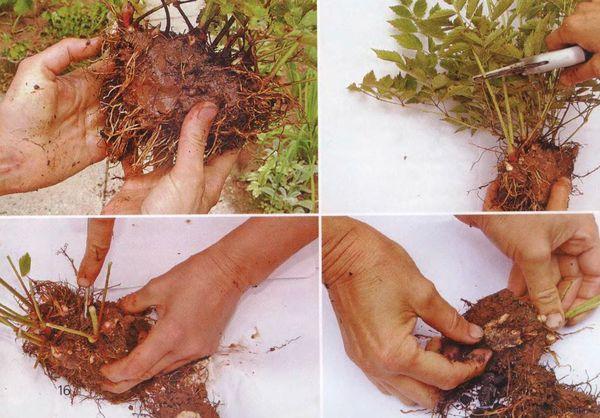
When propagated by "own" seeds, varietal properties are lost. With high-quality hybrid seeds, everything will work out:
- The seeds are stratified, that is, they are kept for 20 days at temperatures from –4 to + 4 дней.
- Then spread over the moistened soil.
- When the first shoots appear, the soil is irrigated with a syringe.
- Two real leaves - which means you can dive a seedling to a third of the root.
- At the end of spring, you can, by shading, plant sprouts on a prepared bed.
Renal renewal:
- In the spring, the bud is cut off along with a piece of rhizome.
- Both sections are treated with ash.
- The buds are buried in a mixture of gravel and peat (1: 3) and covered with a film.
- Sprouts are planted in place in the fall or next spring.
When dividing the Delft Lace bush, it is dug up and the rhizome of Astilba is cut into pieces with a sharp shovel or knife so that each has from 1 to 5 buds of renewal. Plants are planted immediately so that the roots do not have time to dry out. New bushes are watered every day.

